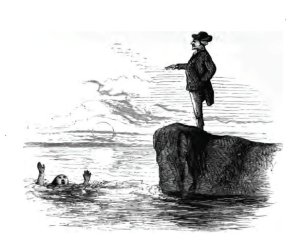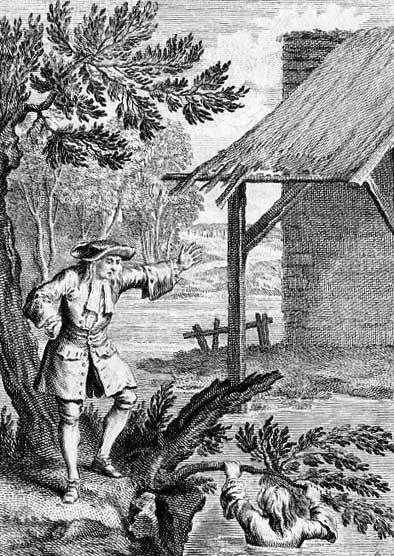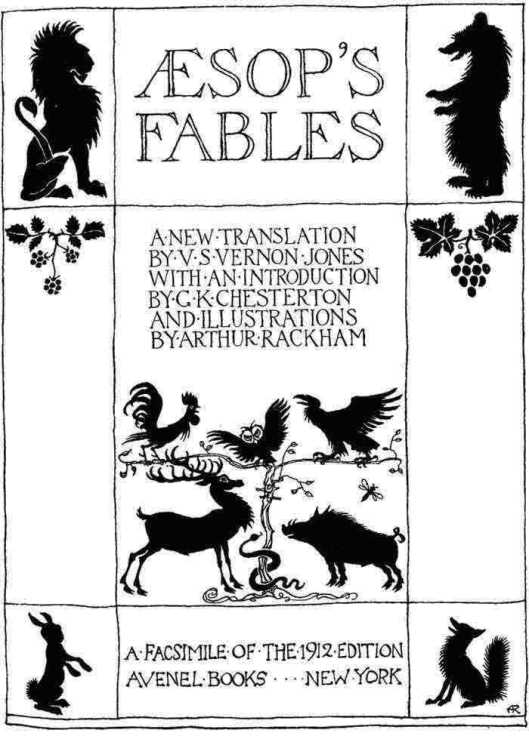Tags
Aesop's Fables, Arthur Rackham, Ben Edwin Perry, G. F. Townsend, Gutenberg #11339, Gutenberg #21, Jan M. Ziolkowski, Jean de La Fontaine, L'Enfant et le maître d'école, Perry Index 211, The Boy Bathing, V. S. Vernon Jones.
![The Boy Bathing Arthur Rackham (Photo credit: [EBook #11339]](https://michelinewalker.com/wp-content/uploads/2014/09/untitled.png?w=300&h=183)
The Boy Bathing, V. S. Vernon Jones (translator), G. K. Chesterton (introduction) Arthur Rackham (illustrator), 1912 (Photo credit: Gutenberg [EBook #11339])
The Boy Bathing
A Boy was bathing in a river and got out of his depth, and was in great danger of being drowned. A man who was passing along a road heard his cries for help, and went to the riverside and began to scold him for being so careless as to get into deep water, but made no attempt to help him. “Oh, sir,” cried the Boy, “please help me first and scold me afterwards.”
Give assistance, not advice, in a crisis.
The Boy Bathing
A BOY bathing in a river was in danger of being drowned. He called out to a passing traveler for help, but instead of holding out a helping hand, the man stood by unconcernedly, and scolded the boy for his imprudence. ‘Oh, sir!’ cried the youth, ‘pray help me now and scold me afterwards.’
Counsel without help is useless.

The Boy Bathing, G. F. Townsend, translator, Harrison Weir, illustrator, 1867 (Photo credit: Gutenberg [EBook #21])

L’Enfant et le Maître d’École, Jean de La Fontaine (Photo credit: Musée Jean de La Fontaine)
Æsop’s Fables : c. 620 – 564 BCE
Æsop (c. 620 – 564 BCE) Phædrus (c. 15 BC – c. 50 CE) Babrius (c. 2nd century CE)Fables[i] are a source of wisdom and La Fontaine‘s, little jewels. There are several sources of fables, but the above, A Boy Bathing is an Æsopic or Æsopian fable retold by translators of Phædrus (Latin) and Babrius (Greek). Babrius, however, was a Roman.
Æsop, assuming there was an Æsop, was a freed Greek slave who did not write fables. We do not have a manuscript of Æsop’s fables. The fables told by Æsop were therefore transmitted through an oral tradition. They were not written down until Phædrus and Babrius committed them to paper in Latin and in Greek, at which point they entered the learned tradition.[ii]
Doubt lingers as to whether or not there ever lived an Æsop. La Fontaine wrote a life of Æsop and so did other writers. In the case of La Fontaine, writing a biography of Æsop was a way of negating authorship of his own fables.
Under Louis XIV, a friend of Nicolas Fouquet could not chronicle the excesses of his century in a direct manner. To protect himself, La Fontaine borrowed the subject matter of fables and usually featured anthropomorphic animals, humans in disguise. Never would Louis XIV, Sun King, have suggested that he was the lion king of La Fontaine’s Fables.
Ben Edwin Perry (1892–1968) : the Perry Index
There may not have been an Æsop, but there is a body of fables called Æsopic or Æsopian. An index of Æsopic fables was compiled by Ben Edwin Perry (1892 – 1968), a teacher at the University of Illinois at Urbana-Champaign, from 1924 to 1960.
The Wikipedia entry on the Perry Index lists 584 fables, but Wikipedia provides a list of “extended,” fabulists (585, etc.), three of whom are Paulus Diaconus (Paul the Deacon; c. 720s – 13 April probably 799), Odo of Cheriton (c. 1185 – 1246/47), and Romulus FR.
Characteristics of Fables
- they usually feature talking animals;
- in ancient Greece, fables that featured animals were called Æsopic and those that featured humans, Sybaritic;
- for Isidore of Seville, fables were Æsopic (animals [souls], or “cities, trees, mountains, rocks, and rivers” [no souls]) or Libystic, “Libystic fables are those in which there is a verbal interchange of men with animals or animals with men.”[iii]
- fables are an example, but there is a genre called Exemplum;
- the example is the story. Humans remember stories because they illustrate. We are reminded of illuminated manuscripts;
- the animals used in fables are anthropomorphic. They are humans in disguise, as animals;
- anthropomorphism both shows and hides human behaviour;
- children may think that the animals are quite foolish and believe that the manner in which they behave is just fine;
- many authors have written fables but are not known as fabulists;
- beast literature overrides genres; &c
Conclusion
I have posted a complete list of the fables discussed on this blog, but there is so much more to say. Fables are very complex and may have several morals.
I must close, but not without saying that I am so sorry we lost Steven Sotloff. His poor family! Next, they will kill a British citizen.
My kindest regards to all of you.
RELATED ARTICLES
- Madame de Sévigné on Vatel’s Death (8 August 2014)
- La Fontaine’s Fables compiled & Walter Crane (25 September 2013 and 2 September 2014)
- Vaux-le-Vicomte: Fouquet’s Rise and Fall (20 August 2013)
Sources and Resources
- Perry Index 211: The Boy bathing in the River (Wikipedia – the free encyclopedia)
- V. S. Vernon Jones, Project Gutenberg [EBook #11339]
- John Fyler Townsend 205: The Boy Bathing
- La Fontaine: L’Enfant le Maître d’École (I.19) FR (I of XII books)
- La Fontaine: The Boy and the Schoolmaster (I.19) EN
- I have not found this fable in the Aarne-Thompson-Uther motif index. Antti Aarne was the pioneer. He was followed by Stith Thompson. In 2004, Hans-Jörg Uther published his Types of International Fokltales: A Classification and Biography.
- Aarne–Thompson classification system – Wikipedia, the free encyclopedia
- Wikipedia – the free encyclopedia (various links)
____________________
[i] “fable.” Encyclopædia Britannica. Encyclopædia Britannica Online. Encyclopædia Britannica Inc., 2014. Web. 04 Sep. 2014. <http://www.britannica.com/EBchecked/topic/199714/fable>.
[ii] Ben Edwin Perry, translator, Babrius and Phædrus, Fables (Harvard University Press, Loeb Classical Library 436, 1965). (scroll down a little)
[iii] Jan M. Ziolkowski, Talking Animals, Medieval Latin Beast Poetry, 750 – 1150 (Philadelphia: University of Pennsylvania Press, 1993), pp. 18 -19.
—ooo—
Bach / Marcello Adagio – Concerto in D minor
© Micheline Walker September 4, 2014 WordPress



Very nice blog. Great job. Hugs, Barbara
LikeLike
Dear Ina,
I thank you for your comment.
At the moment, it is difficult for me to concentrate on posting articles because the situation in the Middle East is very serious and difficult to address. Providing information on a common legacy is difficult. But we share the same fables which suggests a common wisdom. Peace does not have to be just a dream; it could be a reality. The key could be education.
Big hugs,
Micheline
LikeLike
Me complacen en informarte que has sido nominado al DARDOS, un premio que se pasa de blog a blog para demostrar que ahí estamos, y para ayudar a difundirnos también.
El enlace de la nominación: http://ecosocialojocritico.wordpress.com/
Como siempre, ¡nos seguimos leyendo!
¡Saludos!
LikeLike
Eso me gusta mucho: “ahi estamos.” Aqui estoy también. Muchas gracias. Voy a seguirle. Salutations et mille fois merci! Micheline
LikeLike